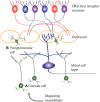The adaptive significance of adult neurogenesis: an integrative approach
- PMID: 23882188
- PMCID: PMC3712125
- DOI: 10.3389/fnana.2013.00021
The adaptive significance of adult neurogenesis: an integrative approach
Abstract
Adult neurogenesis in mammals is predominantly restricted to two brain regions, the dentate gyrus (DG) of the hippocampus and the olfactory bulb (OB), suggesting that these two brain regions uniquely share functions that mediate its adaptive significance. Benefits of adult neurogenesis across these two regions appear to converge on increased neuronal and structural plasticity that subserves coding of novel, complex, and fine-grained information, usually with contextual components that include spatial positioning. By contrast, costs of adult neurogenesis appear to center on potential for dysregulation resulting in higher risk of brain cancer or psychological dysfunctions, but such costs have yet to be quantified directly. The three main hypotheses for the proximate functions and adaptive significance of adult neurogenesis, pattern separation, memory consolidation, and olfactory spatial, are not mutually exclusive and can be reconciled into a simple general model amenable to targeted experimental and comparative tests. Comparative analysis of brain region sizes across two major social-ecological groups of primates, gregarious (mainly diurnal haplorhines, visually-oriented, and in large social groups) and solitary (mainly noctural, territorial, and highly reliant on olfaction, as in most rodents) suggest that solitary species, but not gregarious species, show positive associations of population densities and home range sizes with sizes of both the hippocampus and OB, implicating their functions in social-territorial systems mediated by olfactory cues. Integrated analyses of the adaptive significance of adult neurogenesis will benefit from experimental studies motivated and structured by ecologically and socially relevant selective contexts.
Keywords: adaptive significance; adult neurogenesis; evolution; olfaction; pattern separation.
Figures









Similar articles
-
Juvenile neurogenesis makes essential contributions to adult brain structure and plays a sex-dependent role in fear memories.Front Behav Neurosci. 2012 Feb 2;6:3. doi: 10.3389/fnbeh.2012.00003. eCollection 2012. Front Behav Neurosci. 2012. PMID: 22347173 Free PMC article.
-
Anxiety- and Depression-Like States Lead to Pronounced Olfactory Deficits and Impaired Adult Neurogenesis in Mice.J Neurosci. 2016 Jan 13;36(2):518-31. doi: 10.1523/JNEUROSCI.2817-15.2016. J Neurosci. 2016. PMID: 26758842 Free PMC article.
-
The functional significance of newly born neurons integrated into olfactory bulb circuits.Front Neurosci. 2014 May 26;8:121. doi: 10.3389/fnins.2014.00121. eCollection 2014. Front Neurosci. 2014. PMID: 24904263 Free PMC article. Review.
-
Altered Morphologies and Functions of the Olfactory Bulb and Hippocampus Induced by miR-30c.Front Neurosci. 2016 May 9;10:207. doi: 10.3389/fnins.2016.00207. eCollection 2016. Front Neurosci. 2016. PMID: 27242411 Free PMC article.
-
The interplay between reproductive social stimuli and adult olfactory bulb neurogenesis.Neural Plast. 2014;2014:497657. doi: 10.1155/2014/497657. Epub 2014 Jul 22. Neural Plast. 2014. PMID: 25140258 Free PMC article. Review.
Cited by
-
Development of circadian oscillators in neurosphere cultures during adult neurogenesis.PLoS One. 2015 Mar 31;10(3):e0122937. doi: 10.1371/journal.pone.0122937. eCollection 2015. PLoS One. 2015. PMID: 25826427 Free PMC article.
-
Cell Proliferation in the Adult Chicken Hippocampus Correlates With Individual Differences in Time Spent in Outdoor Areas and Tonic Immobility.Front Vet Sci. 2020 Aug 26;7:587. doi: 10.3389/fvets.2020.00587. eCollection 2020. Front Vet Sci. 2020. PMID: 33005647 Free PMC article.
-
Axonal localization of the fragile X family of RNA binding proteins is conserved across mammals.J Comp Neurol. 2020 Feb 15;528(3):502-519. doi: 10.1002/cne.24772. Epub 2019 Oct 10. J Comp Neurol. 2020. PMID: 31502255 Free PMC article.
-
An experimental framework for conjoint measures of olfaction, navigation, and motion as pre-clinical biomarkers of Alzheimer's disease.J Alzheimers Dis Rep. 2024 Dec 23;8(1):1722-1744. doi: 10.1177/25424823241307617. eCollection 2024. J Alzheimers Dis Rep. 2024. PMID: 40034341 Free PMC article. Review.
-
Circadian Clock Genes Are Essential for Normal Adult Neurogenesis, Differentiation, and Fate Determination.PLoS One. 2015 Oct 6;10(10):e0139655. doi: 10.1371/journal.pone.0139655. eCollection 2015. PLoS One. 2015. PMID: 26439128 Free PMC article.
References
LinkOut - more resources
Full Text Sources
Other Literature Sources
Miscellaneous

